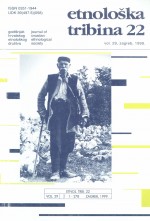Nevjenčani brak
Common-Law Marriage
Author(s): Magdalena MijakovićContributor(s): Snježana Ivanović (Translator)
Subject(s): Law, Constitution, Jurisprudence, Customs / Folklore, Civil Law, Cultural Anthropology / Ethnology, Family and social welfare
Published by: Hrvatsko etnološko društvo
Keywords: wedding customs; common-law marriage; Lika;
Summary/Abstract: After a thorough critique of the sources and attempts of a more precise definition of the term common-law marriage the author observes this phenomenon in the correlation with related topics: trial marriage and irregular ways of marrying, with which the institution of common-law marriage is closely connected. The phenomenon of common-law marriage is characteristic for the major part of Lika. Insufficiently reliable, precise and clear data, and diversity in details, make a more precise categorization as well as definition of the term Common-law marriage difficult. After the analysis of the data the author has singled out two types of common-law marriage and marked them as: 1. Temporary common-law marriage, which would be a marriage lentered! after the agreed taking away of the girl, regardless the reason for such a way of marrying; when parents accept the situation, mostly after a short period of time or after the birth of the first child the latest, a formal marriage is contracted; 2. Permanent common-law marriage, in which the couple through a longer period of time (sometimes for life) live in extramarital relationship; it seems that the parents agree to such a decision of their children, sometimes some pre-marital or wedding customs are preformed as well. Thus, according to the folk understanding performance of certain pre-marital customs, and even the wedding itself without legal wedding, gives the marriage its legitimacy, so it could be presumed that it is the relict of the customary legal traditional concept of marriage. Due to the insufficient reliability of all available data, confirmations of this way of entering a marriage are rare at present. A more thorough data analysis still makes it possible to, at least partly, shed some light on the problems related to this phenomenon and raises a range of new questions that will have to be taken into consideration in future research. This research should precisely define whether really there existed these two categories of common-law marriage, how they differed and how they were called, as well as determine their spread over the whole area of Like, and then in other parts of Croatia where there are traces of the institution of common-law marriage.
Journal: Etnološka tribina : Godišnjak Hrvatskog etnološkog društva
- Issue Year: 29/1999
- Issue No: 22
- Page Range: 163-187
- Page Count: 25
- Language: Croatian

